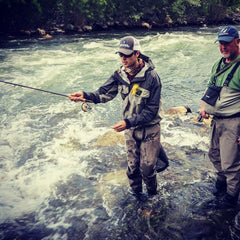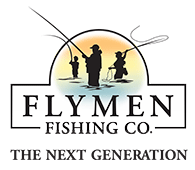Fly Fishing for Predators: 3 Ways To Entice an Aggressive Eat

Your Fly Is the Most Critical Part of Your Setup
It doesn’t matter if you’re throwing it on your new $500 rod, or fish scale print reel, or in the newest wading shoes.
If your fly doesn’t fish, the fish won’t eat it.
That being said, a fly is only as good as its presentation. Your fly might be the best-looking, most lifelike imitation ever tied. It might perfectly match the hatch, down to the exact shade and color; however, it's only as good as the angler throwing it.
My aim is to give you some perspective on how I fish a streamer and why, hopefully increasing the effectiveness of the flies already in your box.
I believe there are two responses you can achieve from engaging a fish:
- A feeding response.
- An aggression response.
Therefore, there are two primary ways to present a fly – one to engage a feeding response and one to entice aggression. Both are extremely effective, and both have the potential to produce large fish.
Engaging the feeding response is all good and dandy, and is certainly a successful way to pursue fish.
However, I personally aim to engage the aggression response 90% of the time, and the excitement, visual impact, and adrenaline rush that comes with moving a trophy fish continues to encourage my stubbornness.
Predators are big, lazy, and opportunistic. They typically feed around sunrise and sunset, and take catnaps in the afternoon and evenings. They spend their long, sunny, daylight hours watching other smaller fish swim around. They don't want to waste energy chasing down healthy fish; they much prefer waiting for a weakened, easy meal to come to them.
Waiting... Then reacting.
When fishing streamers, I try to present an opportunity to these predators. I want my fly to look like it's fleeing for its life, but something is terribly wrong; it's wounded, sick, erratic, easy to capture – a meal worth chasing down.
It's in these moments the predator sees his opportunity and makes his move.
Here are three ways to create those "opportunities" for predatory fish and entice an aggressive eat.
1. Slap Happy

Fish-Skull Sculpin Helmets get the job done.
Have you ever stuck your head under water when you’re wading a river?
There's a ton of noise – constant noise!
The sound of rushing water, the acoustics of water pushing up against rocks, or over specific substrates, or down a section of rapids. A predator’s lateral line is constantly being stimulated, dissecting current velocities and looking for holding pockets.
Sometimes, all it takes to wake him up is a slap.
The slap serves two purposes:
- To startle the fish.
- To bring attention to your fly.
When you scare something, its brain immediately reacts with one of two choices: fight or flight.
Yes, smaller fish will spook, but the big boys typically come out to play, and it’s a game you don’t want to miss.
3 Articulated Streamer Fly Styles That Simply Get ‘er Done
The slap is my #1 go-to presentation when water is high and dirty, and also in rivers with intense elevation changes.
Here in Duluth, Minnesota, many of the creeks I fish for brook trout are more or less a continuous series of waterfalls. Each pool below a series of falls typically holds one heavyset brookie, and the slap hasn't failed me yet.
I recommend fishing it close (no more than two rod-lengths away), landing it one to two feet from the bank, and taking four to five rips. If nothing shows, keep moving. Make a cast, take two to three steps.
You're looking for players, and the best way to find them is to cover as much water as possible.
2. Jerk Strip

Nobody likes to waste energy.
A predator doesn’t want to enter a marathon just to get a Big Mac – the calories it gains won’t be greater than the calories it expends.
When you retrieve your fly, the goal isn’t to swim it like a fish. The goal is to swim it like an easy-to-hunt, wounded fish!
Kelly Galloup’s jerk strip retrieve is designed to do just that. Simply put, the jerk (performed with the rod tip) animates the fly in 3" to 6” intervals, while the strip picks up the slack created by the jerk and brings you tight to the fly.
The idea is to make the fly swim erratically, with an animation followed by a short pause.
The Art of Stripping Streamers: Fly Fishing Tactics
This retrieve can be performed at basically any speed, ranging from constant animation to longer pauses. ALWAYS use variation!
Jerk jerk, strip, jerk, strip, jeeeeerk, strip, pause…
The fish know what they want. Be observant. By varying a retrieve, you allow the fish to react to a range of stimuli, and you can narrow down the retrieve speed and pause duration based on their reactions.
I prefer to fish all my streamers heading either across or downstream. Both scenarios play in the favor of the jerk strip. When wounded fish try and escape, they do so by heading downstream, and the jerk strip allows you to always remain in position and ready to set.
3. Go Big or Go Home

Fish that eat meat are ordering 16 oz. ribeyes, not the caesar salad.
When you “go big,” be conscious of the ecosystem you're interacting with – are you fishing for 10” brook trout in a creek, or 20” browns from a large tailwater?
A large fly for one scenario may not be a large fly in the other. Regardless, I encourage you to push the limits.
When a big trout turns to the dark side and shuns his dry-fly-eating friends, he's not just feeding on 1" to 2” minnows and fingerlings. He's, more likely than not, eating his old dry-fly-eating friends.
Trout Fly Fishing: 3 Bad Habits to Break
I’ve had browns chase down and crash an 8” pike fly, and I’ve had brookies crush a 4” articulated zonker. Their consciousness of being the top predator is what makes them vulnerable to big flies.
By upping the fly size, you weed out the smaller fish that may be reacting on a feeding response, and you start finding the hogs that are laying and waiting, waiting to act out in aggression.
You may just fall in love with the rush. The feeling of adrenaline spiking with every flash of golden brown is something worth chasing.
Want More Articles Like This?
Join the Flymen Mailing List at the Bottom of the Page!
About Gunnar Brammer:

After being afflicted with the fly tying and fishing addiction at the impressionable age of 16, Gunnar spent the next few years honing his skills on the water and at the fly tying desk, including a memorable summer spent working for Kelly Galloup at Galloup’s Slide Inn. In 2015 he launched Brammer’s Custom Flies, a business specializing in musky, pike, and large trout streamers. He’s proud to say the streamers are all his own, but credits his inspiration to many great tiers. He’s actively building out his YouTube channel and Instagram in an effort to provide a wealth of information for others who share his passion for fly tying and fishing. Gunnar recently moved to Duluth, Minnesota with his wife, where he’s looking forward to the challenges of new waters and hopes they will inspire some tasty treats for others to enjoy.


Comments on this post (12)
i been strippin in the evenins. i haven’t found an effective pattern for attracting the dolla dolla billz yall.
— paul worsterberg
Excellent article and just when I needed it. I find myself falling into a routine of simply stripping stripping stripping, more focused on getting my streamer back to the boat and imitating a healthy bait fish, than using the jerk strip to create a pause and imitating an injured bait fish. I may literally take a sharpie and write jerk – strip on my boat LOL
— Drew Gilchrist
another informative and engaging presentation by one of the younger talents teaching me to fish and tie – thanks!
— KENNETH THOMSON
I was happy to see you are too busy on streams to have time to tie flies for sale. You really produce great stuff.
Bob old guy in Cleveland area
— BOB BUCKLEY
Enjoyed your article. Always seeking out advice and information that helps me continue to improve my skills and insight. Thanks for sharing.
— Jeff McClung
I have always enjoyed caddis hatches and mayflies and smaller fish, just to get them to hit….but now I will change tactics and use larger flies…..seems to be the trend and very successful…so I am now a convert….thankyou for all the information in your site….
— John Wilson
I am Brazilian and I like to learn to be a better fly fisherman with your experiences. Thank you.
— Alexandre Tokitaka
Great advice and strategy on fishing streamers.
— Cdrsqd
Thanks, makes total sense. I may even get out there for the enjoyment of it all
— Leo
Thank you for the good advice,
— ken Shewmaker
FINALLY GOOD INFO. THAT I HAVE BEEN IN THE PASS TRYING TO CONVERT THE NON-BELIVERS
GREAT STUFF
— JEAN MAURICE BOURQUE
Loved this article. I have been taking my version of the galloups dungion articulated fly to Pennsylvania for two years now snd have haf several hookups with browns and rainbows over twenty inches but havent landed the first fish. I lose them off of the trailing hook. No breakoffs just spit the hook. I am going to try these same patterns with just one long shank hook and use a wiggle but to entice the strike. Any suggestions?
— Joe Provens